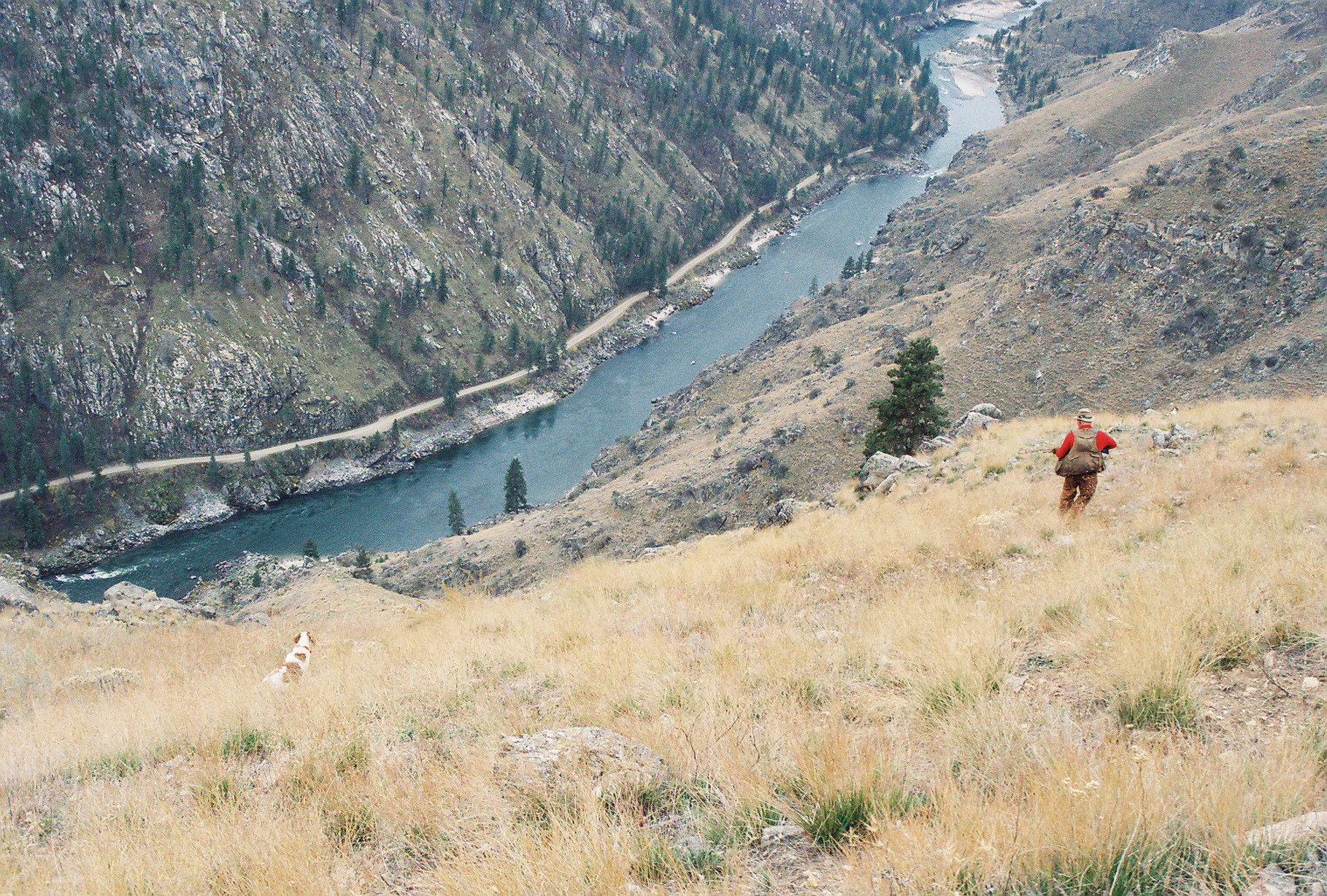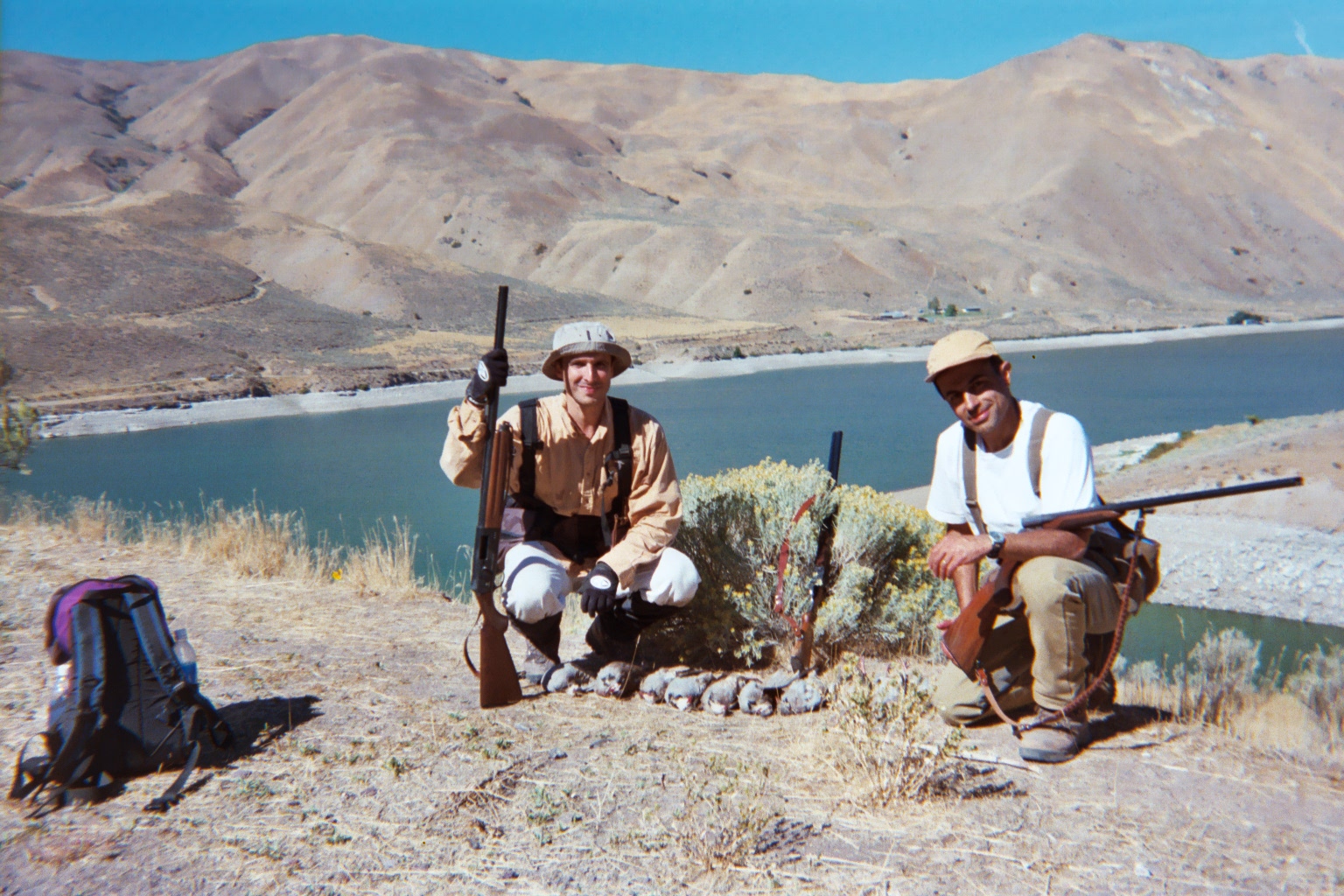A mountain hunt for wild sheep, goats, Ibex, Tahr, or Chamois is exhilarating and the hurdles are many. Consider the expensive travel and tags, the time spent glassing and traversing drainages, examining candidate animals, and formulating a stalk for a shot. A downed bighorn signals the end of the hunt, possibly for life in most US states or at least requires years of waiting for the next tag.
 Idaho’s Typical Chukar habitat
Idaho’s Typical Chukar habitat
This is all worth doing but what if you could hunt mountain game every day for months with the possibility of bagging more than one species on a single day? Maybe you could awaken in the same spike camp to do it again the next day and the next? How about if you got multiple shots almost every outing? How nice that no silent stalking is required and hunting companions converse amiably along the way. And your dog is a welcomed addition! The weather is moderate and finally, your quarry will be there all day so no need to get up at first light.
 Cousins and Chukar hunting partners for life.
Cousins and Chukar hunting partners for life.
I am not dreaming! This hunt happens annually for a group of hardcore wing shooters in many mountainous areas of Western North America and indeed, around the world’s dry mountain ranges. A crazy and passionate bunch, these “Chukar Hunters” converge on North America’s hallowed Chukar grounds of the arid mountains and canyons of the west but arguably, the best of the best is the State of Idaho. This may be due to Idaho’s dry climate, and abundance of exotic cheatgrass, ironically, an exotic grass from the same southeastern Asia region as Chukars native range as well as my parent’s homeland. Coincidence? Maybe not.
 Afshin & I on a fine morning above Brownlee
Afshin & I on a fine morning above Brownlee
Cover and water and Chukars are found in deep canyons and mountainsides but where valley bottoms flatten into rich grasslands, the leg-weary hunter’s game eye switches to California quail, Ring-necked Pheasants and Hungarian Partridge. Just when the tired hunter seeks the shade of willows or spruce trees, they may flush Ruffed and Blue Grouse. Unless you are shooting only steel shot, you will need to pass up the ducks and geese trading up and down the valley Bottom Rivers, however, stay on guard for Mourning Doves and the newly arrived Eurasian Collared Doves moving into the area. This is what makes Idaho the ideal grounds for an “Ultimate Mixed Bag” wing shooting experience. Consider Chukar hunting “sheep hunting for feathers” with nicer weather.
 Yours truly with a “Double Double”!
Yours truly with a “Double Double”!
Chukars (Alectoris chukar) were brought from India to the United States in the 1920s and were released in several Western States as well as in the Similkameen Valley of Southern British Columbia. They have flourished in Idaho, Oregon, and Nevada and have become a wing shooter’s “royal game”. These accolades go to wild Chukars and not pen-raised release birds mostly used for dog-training and easy practice shoots – a very different set of bird behaviours. Chukars are in the family Phaisanidae alongside turkeys, pheasants, quail, wild chickens and peafowl. Mature Chukars are dense with muscle and weigh about a half kilogram. Chukar camouflage comes from magnificent dun contour feathers with neat pinstriped sides. They are explosive flushers, fast flyers and snappy endurance runners in the steepest of hills. Their eyesight is keen and coveys of up to a dozen mean lots of eyes at work, finally and maddeningly, they use terrain to escape over cliff edges and sail across canyons – it is remarkable anyone has ever killed one! Thankfully, they are also a great table fare.
 Phenomenal Idaho!
Phenomenal Idaho!
For weaponry, I prefer a 12 ga SXS with double triggers and a M/F choke combination. The reason is that generally speaking, they flush with lightning speed and typically at the edge of range. The double trigger option gives the shooter the choice to make the selection of the choke as the gun comes up and if all you get is a 50-meter shot, well, the Full choke is the right medicine. How easy or difficult is it to hunt them? The best answer was given by Jim Carmichel in his book “Classic Carmichel” as follows:
“Of the times I have hunted them, the problem was simply trying to stand up in order to get off a shot, because on nearly every flush I’d lose my footing and find myself sliding or falling before I could shoulder my shotgun. After one exhausting day of chasing the fiendish birds, a companion asked me if I thought Chukars were tough targets. I’ll let you know if I ever get a fair shot, I responded”
 Caught in action!
Caught in action!
I come by this Chukar passion honestly. Mine was a Chukar-hunting family with my late dad and my uncle (aka the chief) as master Chukar hunters. They are both in sheep/ibex/chukar heaven now but their memories and teachings are still with me. I have black and white pictures of their hunts with Gunny bags full of Chukars and other game birds including the Himalayan Snowcock from Iran’s high snow-capped mountains. As a child, Chukar was our typical table fare; it was our chicken-replacement. The culture of Chukar hunting was imprinted on my psyche from an early age. The intricacies of finding and hunting them, the staccato laughing call when they are going 100 kph over your head and “the chief” swinging on them with his FN A5 or dad with his Suhl double, a puff of feathers and the tumbling bird are etched as my earliest hunting memories. The rare magic of doubling on Chukars with a delicate Spanish side by side over a steady dog on a Snake River volcanic scree slope will occupy my dreams to my deathbed.
 Shooki in Chukar heaven!
Shooki in Chukar heaven!
In 1999 when my cousin and hunting partner Afshin moved to Boise, I could hear my mother’s voice in her native Farsi saying: “son, your bread is in oil”, meaning that more Chukar hunting opportunities would come my way. In the following years, Afshin and I would make four-day trips to the Chukar canyons of Southern Idaho.
In 2001 we had a stellar year of mild winter and a dry spring for chick survival, I got a call from Afshin that Chukars were abundant and that I needed to get to Idaho ASAP. I packed the truck alongside the non-stop wagging tail of my beloved Brittany Yaeger before we drove nonstop to the Potato State. Afshin’s Brittany Shooki had two good seasons experience and impressed with steadiness to point and shot.
For the next three days in our youthful prime, we terrorized the Idaho steppe, the glassy volcanic rim rocks tore at the dog’s feet, and cut our pants. The valley bottoms and the fields saw our dogs quarter and point again and again. The cool mornings and evenings were for steep sun-baked Chukars and Huns and the blazing mid-day hours were dedicated to Pheasants and Quail where the dogs could dip into water and stop worrying about cacti and rattlesnakes. Afshin was right about the abundance and limits of all four species were common. We may have even stooped to a desert cottontail or two. That hunt was one of the most memorable hunts we had together and the “mixed bag” picture I took of Afshin in his garage brings a flood of warm memories. In a harmonious cultural fit, Afshin has graduated to hawking Chukars with his Goshawk, an endeavour that predates firearms by a thousand years in our Persian birthplace.
 Afshin and his captured/trained Goshawk “Tooran” chasing Chukars around Boise
Afshin and his captured/trained Goshawk “Tooran” chasing Chukars around Boise
So…if you are a passionate mountain hunter and want to experience the “Ultimate Mixed Bag Mountain Hunt” at an affordable price with over-the-counter licenses, look into the arid Western States with huntable Chukar populations. No gym, exercise routine, or even a deer hunt will prepare you for sheep or goat hunting like a Chukar hunt. Even as you walk the desert ranges, you may want a siesta to glass and watch desert mule deer and bighorns before continuing after the feathered rockets. And…you never know…you may end up contracting ”Alectoris febricitantem” — an incurable and chronic disease commonly known as Chukar Fever!











